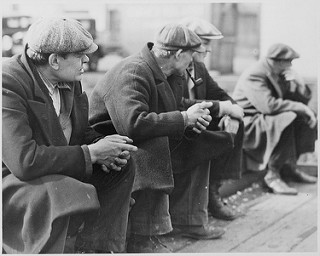You may be surprised how many times we at Postconsumers hear some variation of the following sentence, “I learned to hold onto ‘stuff’ because my parents (or their parents) grew up in the Depression” or “My parents lived through the Great Depression, how do I teach them not to hold on to every single item that they own?”
On the other hand, if you have an older relative in your life who lived through the Great Depression or you yourself did, these statements may not surprise you at all! Today, we’re going to take a look at some of the realities concerning the mental impact of growing up in or being closely related to somebody who grew up in the great depression as well as how to gently try to break the hoarding habit of your Depression-era relative.
The Great Depression Was Very Real … And Very Poor
Even with the current global and U.S. recession, it’s nearly impossible for today’s American generations to understand the depth of poverty that happened during the Great Depression. The American standard of living in the present year is so high that the idea of not having access to clothing or even, in many cases, food is unbelievable (though extreme poverty and hunger are actually quite common in the United States – it’s just pushed under the carpet).
But that wasn’t the case in the 1930s. In fact, quite the opposite was true. Food, in particular, was scarce because the Great Depression happened simultaneously with the Dust Bowl. The Dust Bowl was a gigantic drought in America’s farm region that resulted in a food shortage. So food was in vanishing supply, meaning that it became more expensive. And most people were poor, which meant that it was even harder to afford food.
Surviving the Great Depression By Using Every Available Resource
To survive the Great Depression and make sure that whatever money was available was used for food, parents and families learned to make every available resource stretch – and they taught that technique to their children. Clothing was never thrown out. It was sewn or patched for re-use, and when it couldn’t be worn any longer or handed down to another child, it was made into quilts or other fabric-based needs. Furniture, appliances and anything mechanical that couldn’t be used any longer was saved. After all, you never know when you might need a part from an old piece of machinery or furniture to stop-gap or fix another one.
The “holding on to what you have” philosophy was one of safety. Nobody knew when the Depression would end or if it would get worse. The option to simply buy new things wasn’t there. Most people wouldn’t have survived if they hadn’t learned to “hoard” possessions.
But Then the Depression Ended
Of course, as is evidenced by our opulent lifestyles today, the Great Depression ended. Unfortunately, the mindset of needing to hold on to every single thing a person owned didn’t. And, to a certain degree, one can understand why. It also might be more acceptable if this belief had stayed within a single generation. After all, it is fair that if you once experienced the fear of not having anything, you would then cling to what you did have.
However, not only did the Depression generation themselves become “stuff clingers,” but they transmitted this belief to their children who began to transmit it to their children, and the cycle perpetuated.
What Can You Do If You Want to Ease Your Depression-Era Relative From Hoarding?
If you’ve read the above and know immediately that it describes somebody you know and love, don’t fear! You can begin to release your loved one from a hoarding habit. Just set your expectations properly (they’re not going to become a minimalist) and follow the tips below.
Be Respectful: Now that you understand why your parent or grandparent hoards, you can be more patient about it. Don’t raise your voice at them for saving things. Make sure that they know that you understand the origin.
Celebrate the Good: In fact, you can actually learn something from your Depression-era relative on how to be a better upcycler or recycler. Make sure that you pay attention and learn, and then let them know that you did.
Talk Them Through the Reality: One great way to start getting clutter cleared from the home of your Depression-era relative is to ask them what they would use each item for that they’re holding on to. If they don’t have an answer, it will be easier for them to let go of the item.
Start Small: Don’t try to change habits or clear out an entire house in one event. Begin by cleaning a single drawer out. It will be more manageable – both physically and emotionally.
Keep Communication Open: Keep talking about the history and “stuff” as you work on teaching your Depression-era relative to “let go.” Most older Americans aren’t fans of therapy, but often the only way to change a habit is to truly understand the cause and effect relationship of what created that habit. When you keep the dialogue going, you allow that to happen.
Be Patient: As we mentioned above, it’s unlikely that you’re ever going to change the core of what your Depression-era relative experienced. And that’s not necessarily a bad thing. Learning to live with what we have and re-use items is essentially a good thing. Set reasonable expectations and goals that everybody can achieve.
It’s never too late to help somebody find the satisfaction of enough for today by helping them to let go of an addiction to “stuff.” Simply approach the situation gently and patiently and be sure to have a firm grasp on what caused the mindset to begin with!
Have a fact we missed about the Great Depression and its outcome? Tell us about it on Facebook, Twitter, Pinterest or Instagram.





